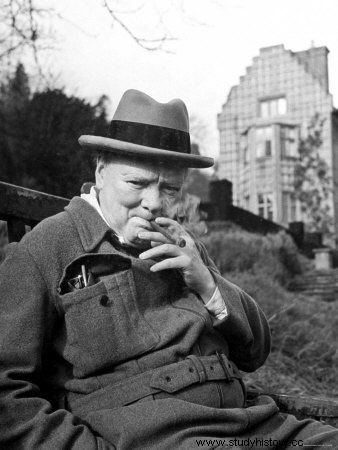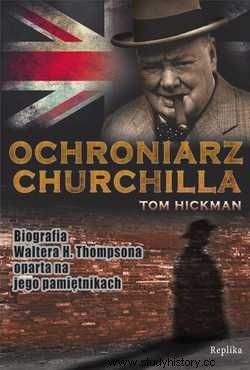Some time ago we told you that the most famous prime minister in the history of Great Britain was involved not only in politics, but also, for example, in painting. By the way, he was the most tearful politician of the twentieth century, and possibly also the dark character behind the murder of Benito Mussolini. Who else?
One of the lesser-known episodes in the life of Winston Churchill is his career ... mason . Although this famous politician came from the British elite, he liked to get his hands dirty from time to time. In the property, purchased in 1922, Chartwell built ponds, ponds and gazebos. Most of the work was done by hired workers, but Churchill decided to take care of the expansion of the swimming pool himself. The sides of the reservoir were lined with bricks and stones . His bodyguard, Walter Thompson, recalled:
Obviously, Winston was an artisan and I was a robotic. I was mixing large amounts of mortar, but still couldn't keep up with the rate at which he was using it. Usually where someone else would apply the mortar with a trowel, Winston would use a shovel .

Churchilll resting outside his Chartwell estate. Perhaps he has just finished the masonry work (Source:The First Pint).
The topic was picked up by the London press, describing Churchill's adventures with bricklaying in its pages. George Hicks, secretary of the British bricklayers' union, also took an interest in the case. He sensed the opportunity and offered the media MP to join the organization. Churchill, like Churchill, agreed, of course, and even paid a premium .
As Tom Hickman, author of Churchill's Bodyguard, explains, the joke was to remind professionals that they should not be working on a bricklayer unless they had a trade union card (p. 87) .
Things got complicated when, after just a few weeks, the invitation was withdrawn under pressure from union members arguing that the minister was not a craftsman. Offended, Churchill decided to prove who was right: angrily refused to return the membership card . The next day, he hired a local builder to erect a new building on the property and announced that he would be helping with the work under his tutelage (p. 82).
This article has more than one page. Please select another one below to continue reading.Attention! You are not on the first page of the article. If you want to read from the beginning click here.
A wall straight as an arrow!
Of course, it took a long time for the busy politician to find a free moment to actually visit the construction site. It is best to quote word for word from the memories of his bodyguard and friend Walter Thompson:
"Join Thompson," he said. - "We'll put some bricks." You will arrange, "I replied," not me. "Why not?" He began to ask. "Because I am not a union member, nor do I want to become one." "All right," he said. - "You can just come and watch."
We went to a semi-finished building site. We climbed a tall ladder and I helped him climb the temporary floor. A builder joined us and showed Winston where he should start:he was to put up an inner wall that ran from the outer wall to the center of the building and would divide the two rooms.

Winston Churchill and his faithful bodyguard, Walter Thompson (example illustration from the book:Tom Hickman, Churchill's Bodyguard, Replika 2011).
Winston was busy working all morning until the wall was about his waist . Then a bell rang from the house and he went to lunch. As soon as he was gone, the builder approached me with a worried expression on his face. "Look at this wall," he said. - "If he puts one more layer of bricks, it will all fall over."
I looked at the halfway up wall. Each successive layer from the ground was tilted more and more, so that the wall rose in a slight arch. It pained me to have to tell him about it. I was of the opinion that his feelings had already been hurt enough on the subject of bricklaying. At the same time, the wall could not be left in such a dangerous condition.
"Tear him down," I said, "and put him back while he's at lunch." "I will not destroy it," objected the builder. So I did it myself.
Knowing that it would take the unhurried Churchill a few hours to eat, Walter made sure that a new, even wall was erected. Eventually his employer came back and decided to… check the quality of his own work.
Churchill appeared at the top of the ladder. The builder and his assistants tried to look indifferent when he took me by the arm and dragged me to the center of the floor, where we stood looking at the wall from its end (...). He leaned over and peered at the wall on one side. Then he walked around me and looked at the structure from the other side. Finally, he asked me to step aside so that he could stand directly at the end of the wall and look at its top.
Both hands stretched out in front of him. I looked at the builder worriedly, and he looked at me. "Just look Thompson," said Winston. - "My first try, and it came out straight as an arrow!" The builder burst out laughing uncontrollably. Winston turned to face him with great surprise on his face. "What is it about?" - He asked. "Something hurt," explained the bricklayer (pp. 82-83) .
… and a political show in the style of the twenties

Churchill probably never found out how he really went about putting up the wall, but apparently the experience made him enthusiastic about building.
In the future he turned out to be quite a skilled bricklayer :He built a long, high wall around the Chartwell greengrocer almost on his own, and built a miniature hut in the garden, dubbed "Mary's House." Besides, he was involved in various other, minor projects. The point of this story came a few years later. As the already quoted Tom Hickman writes:
Perhaps trying to strip him of his membership in the bricklayers' professional association was not such a good idea. When the union tried to lower the hourly rate of bricks a few years later, Churchill opposed the House of Commons, arguing that he would be able to build faster himself.
Opposition members began to doubt this, so the future prime minister ordered bricks and mortar to be brought to the courtyard of the Palace of Westminster. Then, in front of the whole crowd of parliamentarians, he erected a perfect wall, faster than the norm proposed by the union. (p. 87) .
He was quite a showman of Churchill!
Source:
The article is based on the book by Tom Hickman entitled "Churchill's Bodyguard" (transl. Kamil Janicki, Replika Publishing House 2011).
